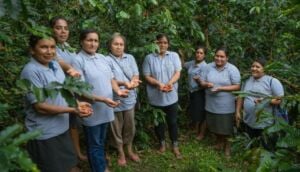The international aid charity CARE was founded 70 years ago to send ‘CARE packages’ of food and other essentials to people in Europe recovering from World War 2. And in putting together and delivering the aid packages, CARE got a lot of help from businesses…
Tea was included in CARE packages sent to Britain (the rest of Europe got coffee):
Cadbury’s chocolate was a big favourite of the families receiving CARE packages, who were still subject to rationing for many years after the war ended (pictured at the top of this article).
And Pickfords helped to deliver the packages:
These are just some of the examples of CARE packages ‘then’ from an exhibition running in London this week (until Sunday 25 October) at gallery@oxo on the South Bank (open from 11am-6pm daily, free admission).
70 years on, there are a lot of parallels to how NGOs and the private sector work together to promote development ‘now’ – such as improving working conditions and access to education and healthcare for workers on tea plantations; or the Cocoa Life partnership between NGOs and Mondelez International which strengthens the cocoa value chain; or CARE’s partnership with Emirates which provides flights for CARE emergency staff responding to disasters.
So NGO and private sector partnerships have always been a part of international aid. To coincide with its CARE Then and Now exhibition, CARE has published a new report on Adding value to value chains – calling on all market actors to work together to enable more people at the bottom of the pyramid to participate in value chains.
The report asks some leading questions: How can market actors work together to manage risk? How can we encourage a holistic approach to value chain development? How can we support innovation and find new, effective ways of promoting value chain development? How can we scale up what works in order to achieve the greatest impact?
Looking ahead, we can also take some lessons from history: together, NGOs and the private sector can achieve a bigger impact in fighting poverty and promoting prosperity than either can do alone.











One Response
Dear Tom,
Thank you for this article, and for the report as well. It is a good reminder of the long role businesses have been playing in the development field, which is now acknowledged at the highest level through the SDGs and the FfD. In your report, you relate partnerships as a relevant tool to mitigate risks and scale up impacts, and demonstrated it through your own partnerships with the private sector and government.
My question has to do with these collaborations and how you manage to make them effective, through e.g. governance structure, risk sharing tools etc. How do you choose your partners, and what would you say is key when engaging in an effective way with private sector actors in the long-term? You also mentioned the importance of having space for trial and thus space for failure if needed (especially in relation with collaboration with donors), do you have any lessons learnt in that regard?
Best regards,
Karim